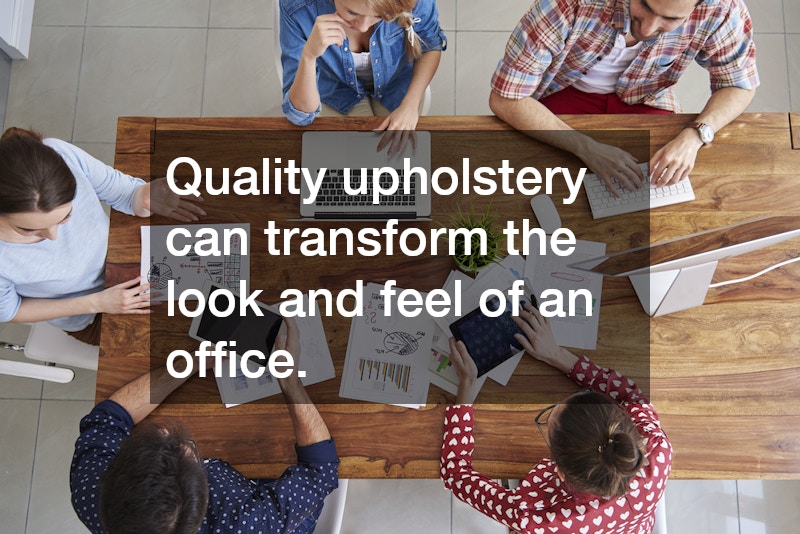
Selecting the right office upholstery for a commercial space plays a crucial role in establishing a comfortable, stylish, and functional environment. Quality upholstery can transform the look and feel of an office, creating an atmosphere that aligns with a company’s brand while providing comfort for employees and visitors. From choosing the right fabric to understanding various design styles, there are several key factors to consider to make an office both inviting and efficient.
Here, we explore a range of office upholstery options tailored to enhance the aesthetic and practical needs of a commercial workspace.
1. Fabric Choices for Office Upholstery
When it comes to office upholstery, the fabric is one of the most critical choices. Different materials offer unique benefits, ranging from durability to aesthetics. Here are some popular fabric options:
-
Leather: Known for its sophistication and durability, leather is a premium choice for executive areas and lounges. It is easy to clean and has a timeless appeal, but it can be costly and may not suit high-traffic areas where scratches or scuffs are likely.
-
Vinyl: Vinyl upholstery is highly durable and easy to clean, making it ideal for areas with frequent usage, such as waiting rooms. Vinyl comes in a wide range of colors and styles and offers a leather-like appearance without the higher cost, making it a practical choice for commercial spaces.
-
Polyester Blends: Polyester blends are popular for office seating because they are stain-resistant and durable. These fabrics hold up well under everyday use, and they come in a variety of patterns and colors, allowing for flexibility in design.
-
Wool: Wool is a natural, durable fabric that offers excellent insulation and comfort. It’s often used in colder climates or for offices aiming for an eco-friendly image, as wool is sustainable and biodegradable. Wool upholstery can be pricier than synthetic fabrics but provides a warm, welcoming look.
2. Durability and Maintenance
Durability is essential in commercial settings, where upholstery experiences high use and needs to withstand daily wear and tear. Office upholstery should be resistant to stains, abrasions, and fading, ensuring it maintains its look over time. Look for fabrics with high double-rub counts (measuring fabric durability) if the furniture will be used frequently.
Maintenance is another critical factor. Low-maintenance fabrics like vinyl and polyester blends are easy to clean and maintain, making them ideal for high-traffic areas. Additionally, stain-resistant treatments can prolong the life of fabric upholstery, keeping it looking fresh and professional without the need for constant cleaning. Regular cleaning routines, such as vacuuming or spot cleaning, can also help maintain the upholstery’s appearance and longevity.
3. Ergonomic and Comfort Considerations
Comfort is vital in any workspace, especially in seating. Ergonomic office upholstery options support proper posture and reduce the likelihood of strain or discomfort, which is essential for productivity and well-being. Look for office chairs with adjustable features, such as lumbar support and seat height, paired with breathable upholstery fabrics that help regulate temperature. Mesh fabric is often used in ergonomic chairs due to its breathability and comfort, making it suitable for long hours of use.
When selecting upholstery for sofas or lounge seating, prioritize plush, supportive materials that balance softness with durability. Cushions should offer firm support without losing shape over time. High-density foam padding in upholstered seating provides lasting comfort, ideal for waiting rooms and break areas where guests and employees alike will spend time.
4. Style and Aesthetic Options
The aesthetic of office upholstery plays a significant role in creating a cohesive look that reflects a company’s culture and brand identity. Upholstery can be customized to suit different interior design styles, from modern minimalism to classic elegance. Here are some design styles to consider:
-
Modern and Minimalist: Simple, clean lines and neutral colors such as grey, black, and white work well in modern office settings. Upholstery with sleek textures like leather or polyester blends complements minimalist interiors, creating a streamlined look that promotes a calm and organized atmosphere.
-
Traditional: For a classic look, choose warm tones like brown, burgundy, or navy in luxurious fabrics like leather or wool. Traditional upholstery styles often include button-tufted backs or rolled arms, which add a sophisticated touch to executive offices or formal meeting rooms.
-
Industrial: Offices in industrial settings can use textured fabrics like leather or distressed vinyl in darker tones for an edgy, modern aesthetic. Paired with metal accents or wood, industrial upholstery can add character to creative workspaces.
-
Eco-Friendly: For offices prioritizing sustainability, eco-friendly fabrics like organic cotton, wool, or recycled polyester are excellent options. Sustainable upholstery helps reduce the environmental impact of office furnishings while aligning with environmentally conscious values.
Choosing the right office upholstery enhances a commercial space by combining durability, style, and comfort in one package. With options ranging from luxurious leather to eco-friendly wool, the right fabric choice can elevate a workspace and align with a company’s values. Additionally, ergonomic considerations, maintenance, and customization allow for a well-rounded approach to selecting upholstery that not only meets functional needs but also creates a positive impression on employees and clients alike. By carefully evaluating materials, design styles, and budget, businesses can invest in upholstery that supports productivity and reflects their brand identity.
.




